Harm van den Dorpel & Jenna Sutela
Two artists talk about biology, computation, complexity, and randomness.

Rare Pepes was a community of meme-makers who traded their art on the Bitcoin-based protocol Counterparty (XCP) from 2016 to 2018. As Blake Finucane writes in a recent essay for Outland, they established many of the standards and values of the NFT ecosystem. While Rare Pepes are now a part of crypto art history, the artists who made them remain active today, especially in the Fake Rares community that formed in 2021, in reaction to the minting of Pepe NFTs on Ethereum to capitalize on the bull market. Rare Scrilla, an artist and collector active in Rare Pepes, started Fake Rares to bring Pepes back to Bitcoin. Below, he looks back on that moment in conversation with Pepenardo, a painter who had not been part of the Rare Pepe community but got involved in Fake Rares early on. They go on to discuss aspects of the Rare Pepe scene that have persisted and evolved in Fake Rares, such as the role of “Rare Pepe scientists,” who review submissions before they’re listed in the directory to ensure they adhere to a few basic criteria. In Fake Rares these moderators are mere “lab assistants,” as if nothing is quite as legit as it used to be. Rare Scrilla and Pepenardo also talk about the diversification of art styles from Rare Pepes to Fake Rares, building community through memes, and Ordinals as one method among many for trading art on Bitcoin.
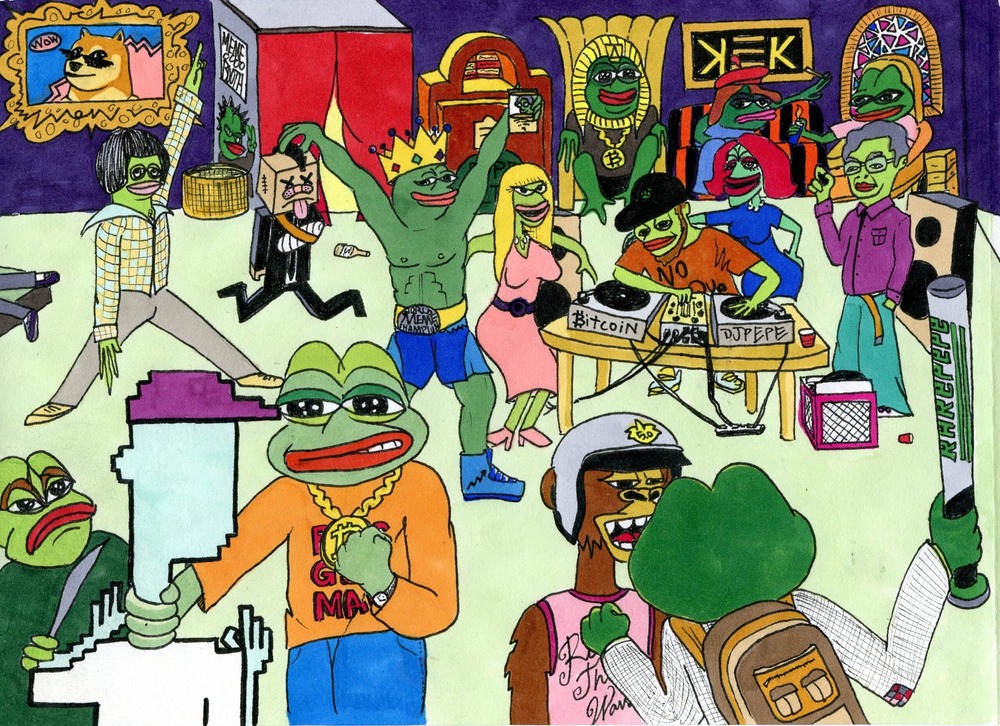
RARE SCRILLA Fake Rares is in its fourth year. It’s a place for artists who put Pepe memes on Bitcoin. There was a huge explosion of NFTs in 2021, and Pepe was included in that. But at that point there were no Pepes being made on XCP, the system had moved over to Ethereum. I don’t want to say I’m a Bitcoin maxi… but I’m basically a Bitcoin Maxi, yeah. That’s the most important thing to me. So I was trying to figure out a way to get the frogs back over to Bitcoin. This moment happened in September of ’21, and a community sprung up really quick.
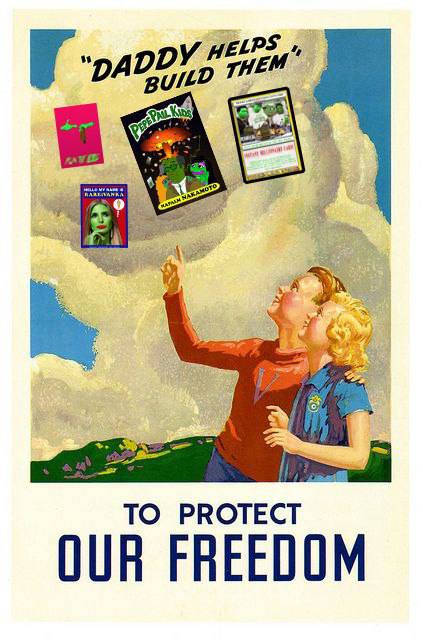
We mimicked the community structure of Rare Pepes. The scientists were joining, it was all good. There were some purists who were against it at first. They told us we couldn’t make Rare Pepes after 2018. We made memes out of the hate. The hate was driving Fake Rares. We weren’t anti-Rare Pepe. I’m one of the largest Rare Pepe collectors and one of the most prolific Rare Pepe creators. I’m not trying to mess up Rare Pepes. It was really to show that derivatives enhance the original, and to bring Pepes back to Bitcoin.
We were lucky that Clubhouse had a Bitcoin room at the time. They were open-minded. They also traded on Ethereum. But they found out that these Rare Pepes existed. Nobody was doing anything on XCP at that point, except for Bitcorns—shout out to them. They were the only XCP community in the dead years of 2018 to 2020. So it was important to bring Rare Pepes back over in a time when everybody was getting hyped about them and putting them all over Foundation.
Rare Pepes belong on Bitcoin. There was an article in Bitcoin Magazine about the interesting parallels between Pepe as a meme and Bitcoin as money. Pepes belong on Bitcoin because it’s a decentralized meme. Anybody can use it. It’s censorship-resistant. That has always been important to me.
PEPENARDO I think it’s really important to understand the foundational components that make up art on Bitcoin versus art on Ethereum. Most of the early Bitcoin collections were very meme- or game-based. I believe that’s a core aesthetic of art on Bitcoin. With Ethereum, people are not necessarily taking art more seriously than on Bitcoin, but they’re treating it more like a traditional art world scene.
Scrilla, you’re a very humble guy, and I know you may not talk about your role in Rare Pepes and Fake Rare unless I stoke the fire. You played a huge role in the introduction of Fake Rares, especially in the way you initiated it, which was a living meme in itself.
It’s important to realize there are rules in the Rare Pepe chat on Telegram. If you broke them you likely got banned. Sometimes you were let back in, sometimes you weren’t. Scrilla had a very good rapport with all the scientists and others in the Rare Pepe community. In 2021 he dropped a “Fake Rare,” a term used back in the Rare Pepe days to describe something that was not certified by the scientists. That term has a history. If you shared a Fake Rare in the Telegram chat, you’d get banned. So Scrilla dropped this Fake Rare as a memetic statement to get banned. Do I have that right?
RARE SCRILLA I don’t think I did it to get banned on purpose. I genuinely found this card that I’d made four years prior and forgotten about. I made my own Rare Pepes, but I also made Rare Pepes for other people. This guy Davesta asked me to make one, and he said he’d send me half the cards when they’re minted. It got rejected from the directory for a few different reasons. I forgot about it. I found it in my wallet as Rare Pepe season was heating up in 2021. I was like, Oh shit, this is fire. So I put it in the Rare Pepe room, without even thinking.
Then I got banned. I work pretty well with chaos, and at that moment I realized I had this opportunity to launch a new directory. I didn’t follow the rules for the ban. I took it as an opportunity. I told people that whoever shares that card in the chat will get one. So it basically became this proof of ban card. Everybody was sharing the card in the Rare Pepe Telegram channel. They’d get banned and come over to the Fake Rare channel. I hit up some of my more Ethereum-based artists, friends, and collectors, and added them all to the chat. And then we just built. It really couldn’t have happened without the community’s involvement.
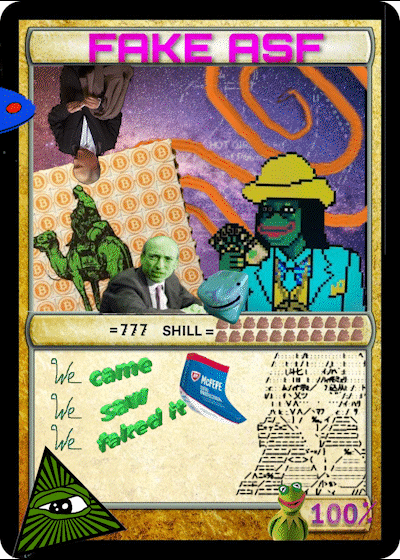
Prior to that, at the end of 2020, I’d started reaching out to people about putting Pepe back on XCP. I’d had this idea in my head for a while. I just didn’t know how to execute it. By the summer of 2021, Rare Papes were flying for so much money that I felt bad for Bitcoin artists, whose work was selling for less. So Fake Rares brought a lot of Ethereum collectors over, people like Vincent Van Dough and his circle. It was the only place Ethereum people were collecting Bitcoin art for a while. Most of the XCP people were happy about it. Since Fake Rares started, there’s been another hundred or so directories that have popped up, bringing a resurgence of Counterparty.
Fake Rares has gone through a few different metamorphoses. It started as a direct replica of Rare Pepes. That was the intention. We only wanted to change a few things. Instead of Pepe Cash we made FAKEASF, a card made by twenty-one artists who were in the chat when we first started and airdropped to everyone who joined the chat early. Rather than burning a bunch of Pepe Cash to get a card you had to destroy one of the FAKEASF cards. Burning is basically the culture of Counterparty—the chain was created by destroying millions of dollars’ worth of Bitcoin. We wanted to keep that alive.
We don’t have scientists like Rare Pepes. We have rude lab assistants who got kicked out of science school. Like with Rare Pepes, you don’t know who the scientists are, unless you’re really in the know. You submit to Fake Rares without knowing who’s reviewing it, and you might get a hit back saying that your card is being published into the directory. That’s all that Fake Rares does, just like Rare Pepe did. Outside of that, the artist is responsible for distribution, marketing, etc. The community is definitely there to help guide people as they come in.
The main difference from Rare Pepes is that Fake Rares is way more competitive, especially in the first year, when there would be a backlog of hundreds of cards to go through. It’s slowed down a lot since, which is pretty typical. When these directories pop up on XCP there’s a manic collection drive, then people splinter off and form their own directories. That’s where we’re at right now.
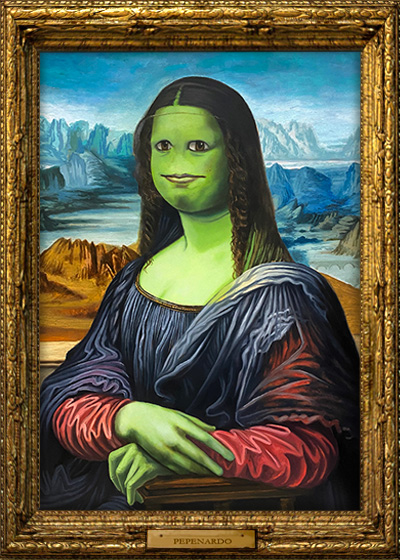
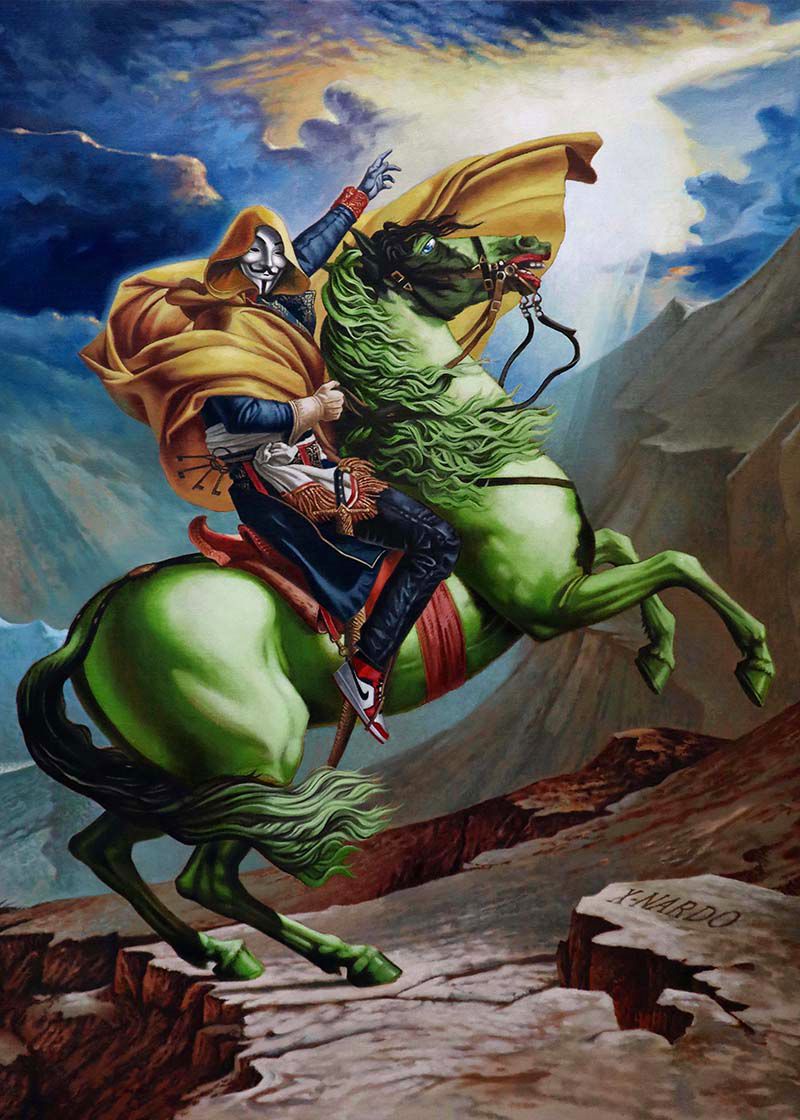
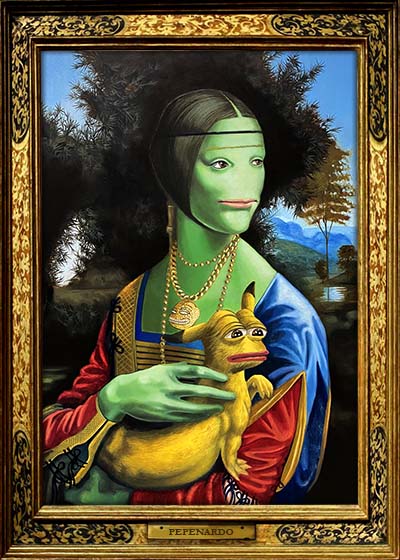
PEPENARDO I wasn’t involved in creating Rare Pepes. I mostly observed from the sidelines. Fake Rares was my entry into crypto art. I had been in the traditional art world for about ten or twelve years prior, then took a break to figure out my life.
I’d always been a fan of Bitcoin, and when I saw the crazy wave of Rare Pepe collecting in ’21, I knew I wanted to make Pepe art. I didn’t know about Counterparty yet. I made my first Pepe art and posted it to Twitter under the Pepenardo name. Then I got linked up with the Fake Rares Telegram and got clued into the submission process. I was making Pepe oil paintings by hand, which takes forever. I was literally working day and night to get these things submitted. Honestly, it was a rebirth into my career with art, because I’d been feeling pretty burnt out.
The oil paintings got some attention because the aesthetic was so different. Rare Pepes had a lo-fi beauty to them. I sometimes joke that the worse it looked, the more rare and expensive it became. By 2021 artists were utilizing more technologies and were more aware of the history of Rare Pepes. Fake Rares opened up an opportunity to experiment with new ways of how a Pepe could exist, so you get that crazy variety and aesthetic experimentation.
RARE SCRILLA When Rare Pepes came out, everybody in the Rare Pepe community was a trader. You had to be, or you would have no idea about it. They’d hear about it from Telegram or Crypto Twitter. That’s why you see that very nostalgic quality—this lo-fi, low-effort way of making Pepes. I really love the aesthetics of it. We call those Dank Pepes. Shout out to Dank Rares, by the way. A dank card is just dope. It doesn’t have to be well drawn or aesthetically pleasing. The message is crystal clear. It’s like the dankness of your mom’s basement, something homegrown. As you get into 2017 and 2018, you see more artists and styles come into Rare Pepes.
The first two series of Fake Rares have a lot more dankness than the rest of the series. And I think that comes from the original community members creating quickly to get into Series #1. They were given FAKEASF because they were there. So the vibe was anything goes. By the time Series #3, #4, and #5 came out, you had more art appreciators and artists coming in. There was a bit of a shift. That’s when the fake lab assistants came in. The first 50 cards were a blur, I think Indelible was helping me, and Fake Annie, but it wasn’t as scientific a process. Later there were more eyes on everything, more strictness. Now we always try to make sure that we have a mixed bag of super high-quality stuff, art from emerging artists, and dankness. Pepe spawned from Matt Furie’s pen. The internet turned that Pepe into Rare Pepe, and remixed these frog faces. Where we’re at now with Pepe is a whole digital art movement; there doesn’t always have to be a frog. It doesn’t have to be green. You can play with color. There’s a whole way of thinking about Pepe now that didn’t exist as much in the time of Rare Pepes. But some of these ideas did seed back then for sure.

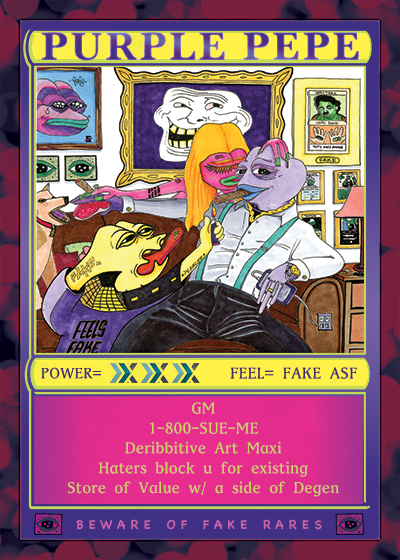
PEPENARDO The variety of aesthetics in Fakes versus Rares partly has something to do with the barrier for entry costs. Back in the day it was a small amount of Pepe Cash. It wasn’t that much, but you still had to know how to get it. So I believe that’s what led to a lot of high-speed, lo-fi art with references to crypto. With the higher expense of FAKEASF, people were spending more time on the actual creation of the work.
RARE SCRILLA The popularity of art references also has to do with collector behavior. At one point collectors were spending 40 ETH or 50 ETH on Basquiat Rare Pepes, so it made sense for artists to go, Oh, shit! Let me remix this Warhol real quick. The tail wags the dog.
PEPENARDO When I first started I was very much referencing art history and embedding Pepe into it. But I’m the type of person who likes to know the core foundation of what I’m doing. When I started making Pepe memes on Bitcoin, I got deep into the background—the symbolism of frogs, the metaphysics of everything surrounding that. I studied 4Chan culture and the philosophy of memes. Back in 2017 Jordan Peterson and Jonathan Pageau talked about the symbology of frogs, and why frogs appear so much throughout human history, drawing connections between Pepe and the frog as a symbol of chaos, which has been consistent throughout history, from the Bible to old German fairy tales like the Brothers Grimm.
So there is a very specific reason that we’re drawn to this particular meme. It’s historically a symbol of disruption that ushers in a new evolution of thinking. It makes complete sense that Bitcoin’s rise as a financial structure should be accompanied by memes of Pepe the Frog. Other Internet memes, like Wojak, are also very primordial. Their popularity is not just happenstance. There’s a Darwinian aspect to memes on the internet. There’s a reason why certain ones survive the longest.
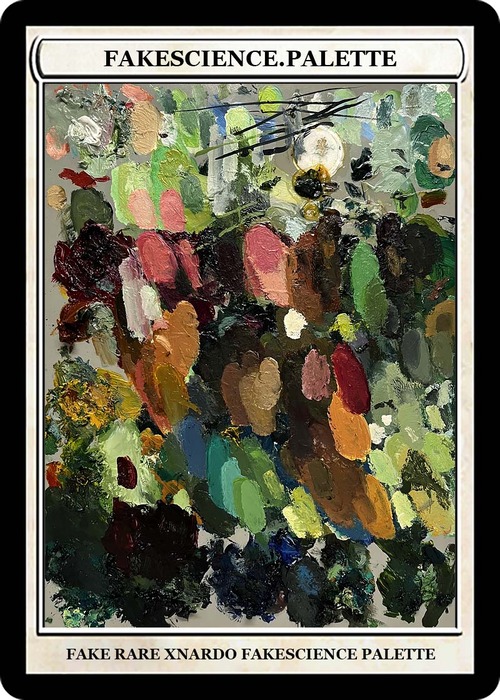
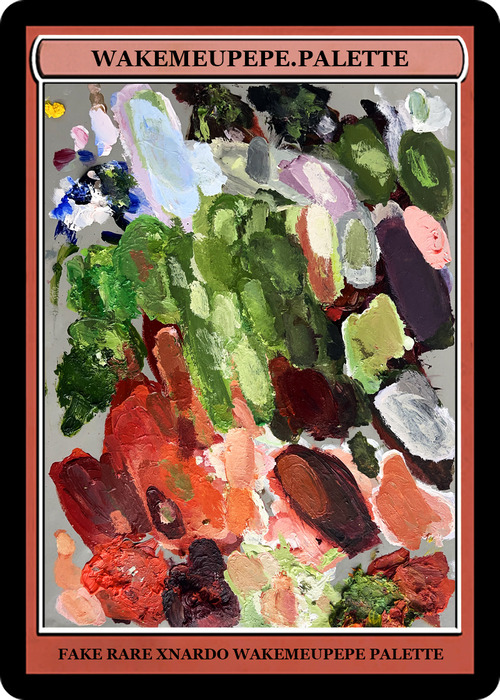
RARE SCRILLA Pepe is the modern-day jester. It’s the clown that tells the truth through humor and irony.
The most interesting period of crypto for me was the fall of 2016 to the spring of 2017, when the Rare Pepe chat was bursting with energy, everybody throwing out every single possible thing you can do with blockchains and art and memes. So many ideas were popping up. Spells of Genesis was making trading cards, and planning a game where you could use them, but the release kept getting pushed back. People were expecting a Rare Pepe game, too. So utility was thrown around a lot. People were making T-shirts. You had private trader groups for Bittrex coins that you needed to own a particular Rare Pepe to access. So I was like, How can I put music on the blockchain using these cards? Another artist made a Biggie Pepe card and I made a six-minute mix for it. I took some Biggie a capellas and remixed them with different beats. The card had a QR code that linked to the music. But the scientists rejected it because QR codes and external links could be changed to something malicious. So Joe Looney [who created the Rare Pepe wallet] and I started playing around with Bandcamp and Soundcloud and Youtube. Finally we figured out a way to create a private playlist on Soundcloud and have it link to the DJ Pepe token through the wallet. So I basically made token-gated exclusives from the cutting room floor, and I’d drop music on that token. It could be an ever-evolving album. Every once in a while I still put a new track up there. But I’m not so big on utility for tokens anymore. It’s more about collecting digital things. Those are the real goods.
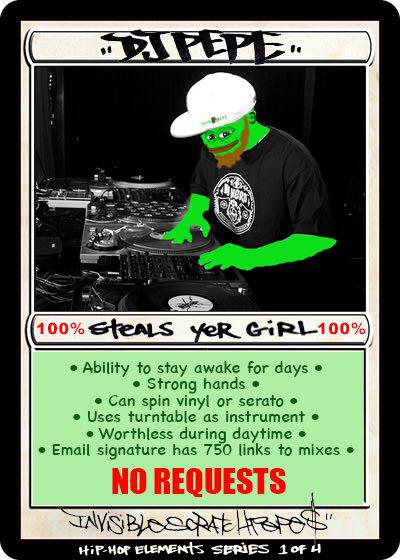
I got into Bitcoin because my friend lived with a miner back in 2012. We were in Arlington, Virginia. We started trying to create a Craigslist-type thing for Bitcoin goods, and quickly abandoned it after the price skyrocketed. We thought we missed the boat. Then Bitcoin went up to 200 USD, and the Silk Road stuff started coming out in mainstream news. As a long-time music producer and DJ, I was looking to do a new album, so I decided I was going to tell the story of the Silk Road marketplace through music. I spent the next year learning everything I could, collecting sound bites, aggregating articles about Silk Road on Flipboard. I tried to sell the album for Bitcoin when it came out, but I had no luck.
When Spells of Genesis came out, I got interested in that—the technology more than the cards. But with Rare Pepes I saw that you could actually create things as an artist and sell them, using the blockchain in ways that hadn’t been explored before. I drew frogs for the next six months straight, just nonstop. I had cards in every series that was coming out. I got interviewed for a book called Blockchain Billions (2017) and one of the authors said to me, “I’ve never heard of anybody using the blockchain to make money outside of trading.” Rare Pepe is really what made the blockchain art scene. It gave us creators and content makers and members a way to sell our work digitally by attaching it to the token. Mike wasn’t putting these things on IPFS or Arweave or anything like that. He was literally putting the image in Telegram, saying this token and this image together are the art piece. It was very conceptual. It took a few weeks until Looney developed a Pepe Wallet where you could have all your cards and images in one place. That stuff sounds stupid now, but it was super groundbreaking at the time.
PEPENARDO I got into Ordinals early. And I think that’s the direction of art on Bitcoin… maybe. The first week of Ordinals was like getting your first Fake Rares in. I call it the Ordinal space race. We were trying to inscribe whatever we possibly could, sub-100, sub-1,000, sub-100,000, sub-1,000,000—all these milestones. So, again, you’d see these crazy lo-fi collections because people were just trying to pump out and inscribe as fast as possible. Early on, we were trying to be very thoughtful about what we were inscribing while also living the reality of that hyperdrive mentality. We were staying up until 4 or 5 am, on the phone together, conceptualizing different collections and inscribing them. Now that we’re well past the point of 1 million inscriptions, heads are turning to see who can inscribe the biggest files. There’s always a new milestone, the next meta.
RARE SCRILLA I love Ordinals. The only problem with Ordinals right now is that the influencers can get a little nauseating sometimes. You get people saying that Bitcoin art didn’t exist prior to Ordinals, but we’ve been beating our drum and memeing to get the train back on the tracks some. The Rare Pepe market is literally the largest market cap of any collection in all of crypto art. How can you fade the biggest project, or re-write history?
PEPENARDO The space is still developing. There are a couple of things that could happen. If fees are going to go higher, artists who want to inscribe Ordinals will be thoughtful and take the time to make something meaningful, perhaps a shift away from the PFP art. There’s more of that now than in those first weeks. Look at Scrilla’s collection “Memetik Artifakes” for The Ones, put out by Bitcoin Art House. You also have the elusive Jack Butcher inscription as one of the largest to hit the chain. I think we’re going to see a shift again in the meta of Ordinals depending on how people deal with the chain and tooling. I also think pretty soon you’ll start to see a shift back to the “historical” or vintage things that were happening on XCP. But it’s the extreme Wild West all over again.
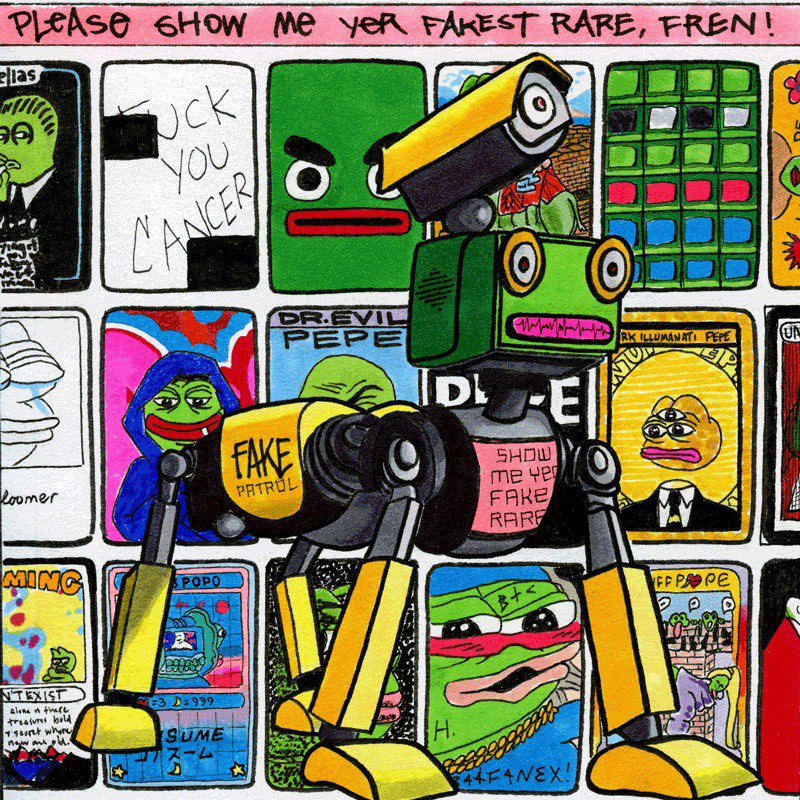
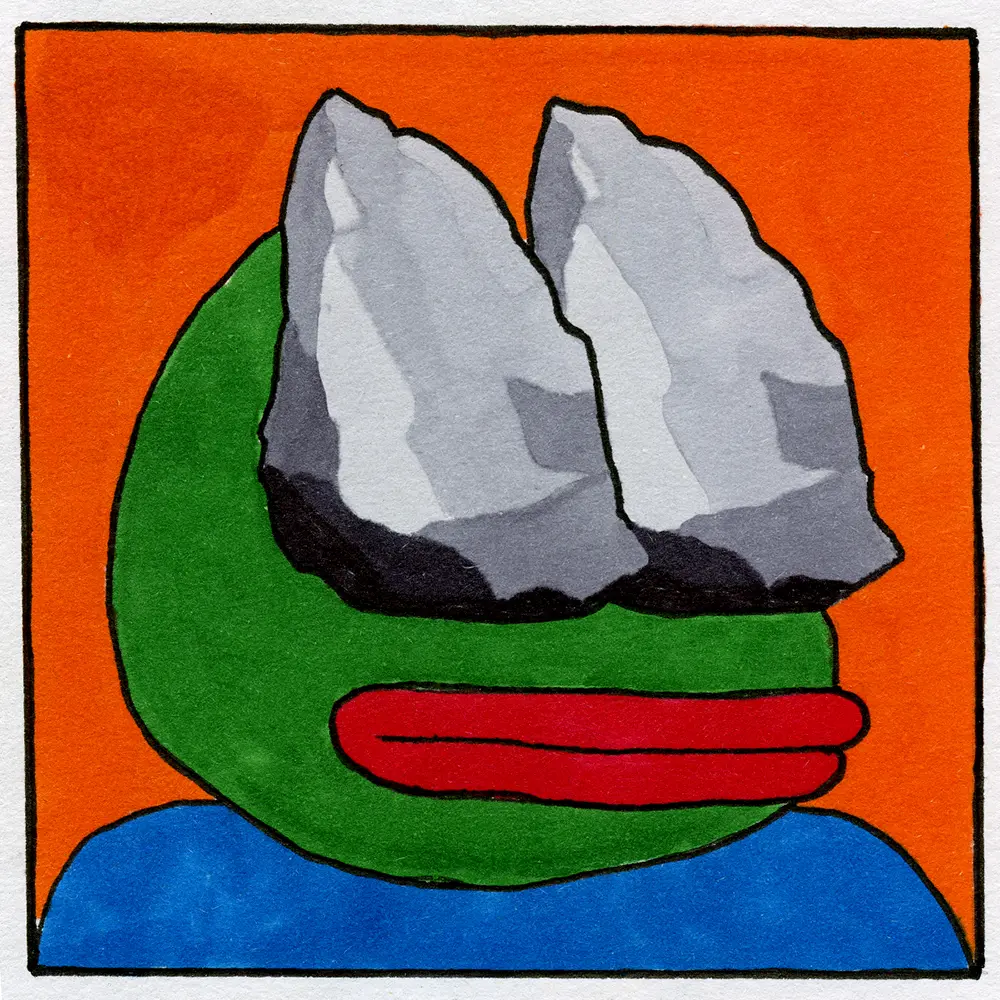
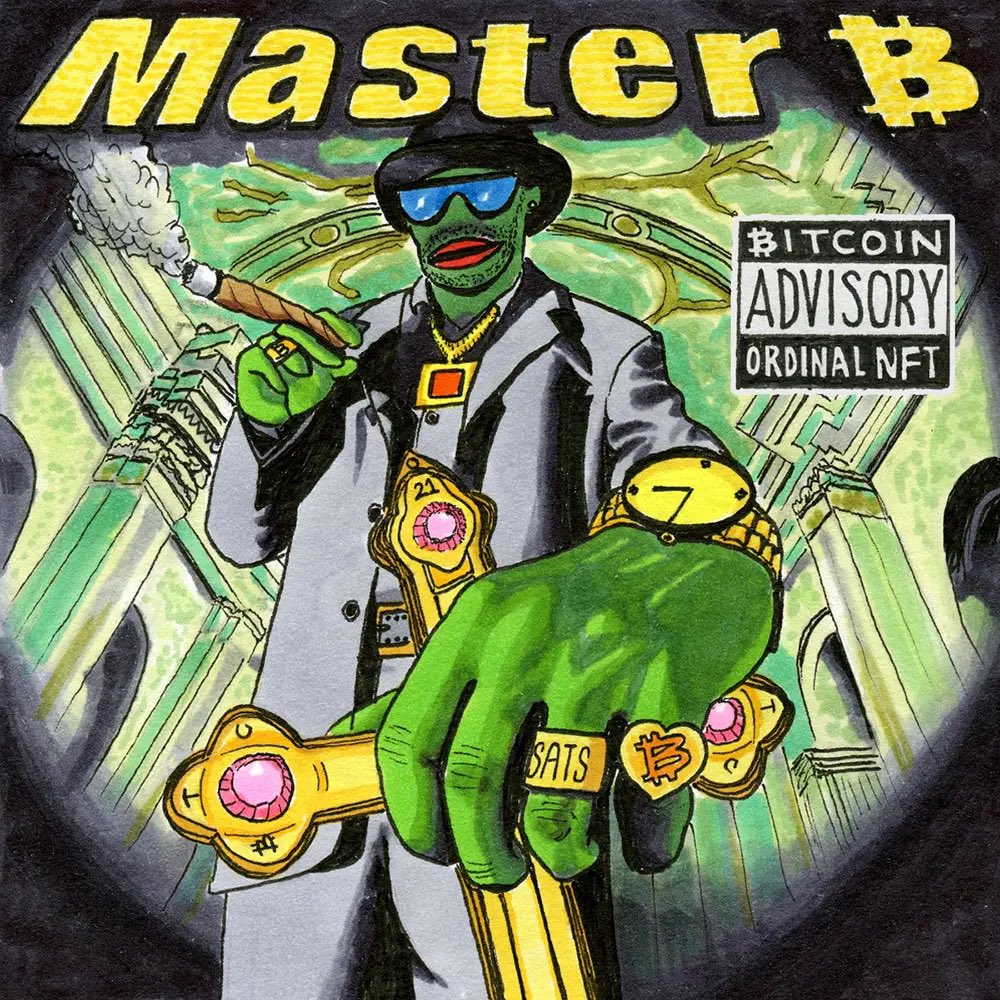
RARE SCRILLA Ethereum is fine. I’ve done some stuff there. It works for a lot of things that you can’t do elsewhere. But I think, ultimately, if you can do something on Bitcoin then Bitcoin is the place to do it, because Bitcoin is the beginning and end of this whole thing. If Bitcoin goes away, everything goes away. It’s the tortoise and the hare. All the alt chains move fast and break things. Bitcoin is not that. Bitcoin sees another chain do something for five years, and then tries to implement it in Bitcoin. Crypto art has a place for multichain for sure. But if you can do something on Bitcoin in a way that doesn’t compromise your art or your vision, then I don’t see why you wouldn’t do it on Bitcoin.
PEPENARDO Rare Pepes utilized Pepe Cash and in Ordinals now we’re seeing excitement around Runes. It’s so funny, because the token creation and utility of Pepe Cash and FAKEASF are very similar to what Runes are doing now.
RARE SCRILLA Yeah. Runes is pretty much XCP but worse. It’s fine. That’s just where liquidity is. But the good thing about XCP is that there are more new mints on XCP every year since 2021 than all years prior. It’s ten years old, but the development has really gone crazy over the last year. I hope and believe in the next two years any Bitcoin marketplace will support the whole ecosystem, both Ordinals and XCP. I can’t see why all these communities can’t flourish.
—Moderated by Brian Droitcour
